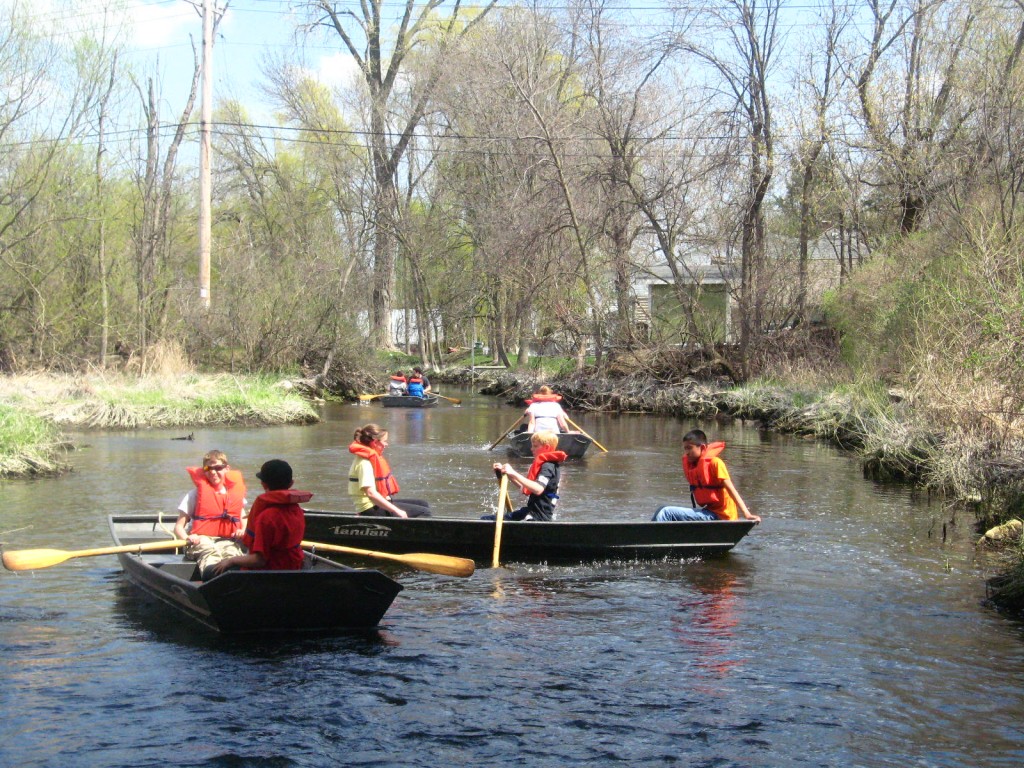The Water Resource Program / Water Resource Fund was officially developed in 1997 by a resolution by the Lake Pewaukee Sanitary District.
Its inception was stemmed from the desire of an educator at ASA Clark Middle school named Ruth LePoidevin, the desire and passion of Charlie Shong of the Lake Pewaukee Sanitary District and an environmental consultant that was working for the district named Mary Eloranta. The program evolved by introducing the concept of service learning to a class of 25 students.
Service learning is a powerful teaching method that integrates community service into the classroom curriculum.
Students felt the river was neglected and was in need of significant improvements. After research and visiting other rivers, the students began to develop a plan for the degrading river.
Throughout development of partnerships with the WDNR and the Lake Pewaukee Sanitary District the students were given the opportunities to apply the knowledge gained from the science curriculum, to real life projects that have made positive changes for the entire community.
At this time funding is being provided by the Pewaukee Water Ski Club, the Kiwanis and The Lake Pewaukee Sanitary District as well as local grants, business and personal donations. However with the recent downturn of the economy this fund is almost completely depleted and is in need of your support.
A first hand introduction is given to the 6th grade students while taking row boats 2 miles down the Pewaukee river. This introduction starts with asking the students how the rain reaches the lake in the first place and “the watershed” is explained. After the details of ditches and storm sewer is explained, notes are given on what pollutants are and how they reach and affect the lake. This leads to the outfall to the Pewaukee river where we stand and view the system. Then questions are asked on what river does the Pewaukee River flow into? Then what river the Fox river flows into? Then what river the Illinois river flows into? Then the Mississippi, until we reach the Gulf of Mexico. So what we do here in our watershed, in some ways affects everyone downstream.
For many students this is the first introduction to the river. Before the students are sent down the river in the duck boats, there is another quick discussion on erosion of the stream banks and litter. The students are briefed on aquatic life, explaining why a deep running stream supports more aquatic life (colder and faster moving water that game fish like) than a shallow silted in stream (that carp like). Details of how the storm water and construction site erosion cause the streams to silt in and what to look for as they float down the stream so they can recognize these issues. They are challenged to find turtles and other aquatic life while they look for garbage or other unwanted issues in the river system.
The students are loaded into duck boats with a set of oars and life jackets to begin their journey. While using teamwork and problem solving to row the boats, the students are able to compare the quality of the river in the restored areas vs the non-restored areas. Each class has a site that they restore along the river each year while they are in 6th grade. These restored areas are a separate class trip down to the river as a “work day”. Typically it is a little work in the morning and a boat trip in the afternoon.
The interest and enthusiasm sparked in the 6th graders encouraged more teachers to come on board over the years. The 7th and 8th grade science teachers have taken their curriculum to the river. Students observe the WDNR electroshocking for a fish survey, collect and classify macroinvertebrates, and perform chemical testing. Comparison of their data in restored and non-restored areas has shown a favorable increase in water quality.
The River Keepers Club evolved out of the students request to want to work on the river after school. The group of students meet once a week in the fall, spring and summer months to learn in the classroom and on site to maintain and restore sites. They pick up garbage, replace rocks and take care of the trails. Fund raising is another event they become involved in. Some students go as far as to do independent studies on invasive species such as purple loosetrife and zebra mussels.
Because of the strong ownership of the river, they have carried the program into the high school. A group of 9th graders were the first students to be trained for a program called “project wet”. This is a curriculum (originally designed specifically for teachers) educates students on the importance of the preservation of water quality.
High school physics class is applying their knowledge at the river by collecting data on stream flow. This data is very important as we work with the village officials regarding the importance of constant flow.
Some of the many activities the students have completed are as follows:
The stenciling of storm drains in the village, restoration of the stream banks, rebuilding of the headwall at the outfall from the lake, boardwalks throughout the watershed, restorations of prairies, and maintenance of prairies.
These activities sparked another River group to come into inception called “The Pewaukee River Partnership” where more adult volunteers from the area have stepped up to the plate in helping the students.
The Water Resource Program has truly made a difference in the schools and the community; the impacts are immeasurable by the constant improvement of the river. Its success comes from the strong school, government and community partnerships that have built the foundation for this program. Please be a part of this wonderful growing opportunity to work together to improve our lake, rivers and watershed.















